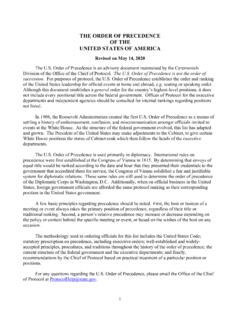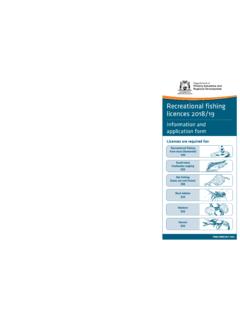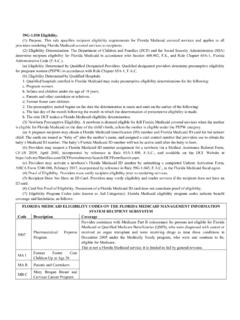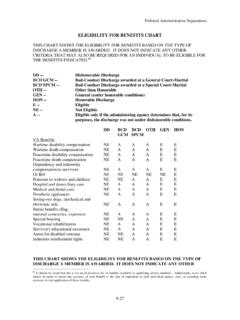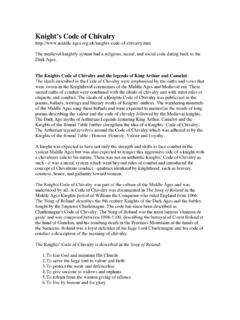Transcription of Poverty Among the Population Aged 65 and Older
1 Poverty Among the Population aged 65 and Older Updated April 14, 2021. Congressional Research Service R45791. SUMMARY. R45791. Poverty Among the Population aged 65 and April 14, 2021. Older Zhe Li Among the aged Population (persons aged 65 and Older ) in the United States, the Poverty rate Analyst in Social Policy (the percentage of individuals living in Poverty , or economic hardship characterized by low income) has declined by over two-thirds in the past five decades. In 2019, approximately of Joseph Dalaker aged individuals had income below the Poverty thresholds (dollar amounts used to determine Analyst in Social Policy Poverty status). However, the number of aged poor has increased since the mid-1970s as the total number of the aged Population has grown.
2 In 2019, million people aged 65 and Older lived in Poverty . The Poverty rate for the aged Population historically was higher than the rates for younger groups, but the aged have experienced lower Poverty rates than children under age 18 since 1974 and lower rates than adults aged 18-64 since the early 1990s. In 2019, the Poverty rate Among individuals aged 65 and Older was lower than the Poverty rate Among adults aged 18-64 and the Poverty rate Among children under 18 years old. Although the Poverty rate has generally declined for the aged Population in most demographic groups, certain subgroups of the aged Population still had disproportionately higher Poverty rates as of 2019. For example: People aged 80 and Older have a higher Poverty rate than other aged people.
3 Approximately of people aged 80 and Older lived in Poverty , compared with Poverty rates of Among individuals aged 75-79, Among those aged 70-74, and Among those aged 65-69. Women aged 80 and Older had the highest Poverty rate Among Older women and men in all age groups at for women aged 80 and Older . Individuals aged 65 and Older who were not married at the time of the survey generally had a higher Poverty rate than those who were married and living together with spouses. Among women aged 65 and Older , about of widows , of divorced women, and of never-married women had total incomes below the official Poverty threshold compared with of married women. Among individuals aged 65 and Older , Poverty rates were also high Among never-married men at Poverty rates vary by race and Hispanic origin.
4 Hispanic origin is distinct from race, and people may identify with one or more races. In 2019, the Poverty rate was Among those identifying as Black or African American compared with for those identifying as Hispanics, for the Asian Population , and for the non-Hispanic White Population . The official Poverty measure used in the United States is defined using cash income only, before taxes, and is computed based on food consumption in 1955 and food costs in 1961, indexed to inflation. That definition prevents the official measure from gauging the effects of noncash benefits, taxes, or tax credits on the low-income Population , and it does not consider how certain other costs, such as housing or medical expenses, might affect them as well.
5 After decades of research, the Supplemental Poverty Measure (SPM) was developed to address some of the official Poverty measure's limitations. The SPM Poverty rate for the aged Population is higher than the official Poverty rate ( compared with in 2019). This higher Poverty rate results largely from higher medical out-of-pocket costs Among the aged . Social Security and Supplemental Security Income (SSI) are the main federally funded programs that provide cash benefits to the aged poor. They accounted for almost 90% of total money income received by the aged Population whose incomes were below the Poverty thresholds in 2019. The federal government also provides certain noncash benefits to help the aged poor, such as housing subsidies and the Supplemental Nutrition Assistance Program (SNAP).
6 In 2019, the SPM Poverty rate Among individuals aged 65 and Older would increase by more than 32 percentage points if Social Security benefits were excluded from their income resources, holding other economic behaviors constant. Among the other resources, eliminating SSI, housing subsidies, or SNAP from income would each increase the SPM Poverty rate by about one percentage point. Congressional Research Service Poverty Among the Population aged 65 and Older Contents Introduction .. 1. How the Official Poverty Measure Is Computed .. 2. Poverty Status of the 3. Poverty Among the aged by Demographic Characteristics .. 6. Age .. 6. Marital Status .. 9. Race and Hispanic Origin .. 12. Federal Programs for the aged 14. The Supplemental Poverty Measure (SPM).
7 17. Income Sources' Impact on Poverty of the aged per the 19. Additional Considerations .. 20. Poverty Not Measured for Certain Populations .. 20. Health Status Not Directly Included in Poverty Measures .. 21. Figures Figure 1. Number of Individuals aged 65 and Older Below Poverty and Poverty Rate, 4. Figure 2. Poverty Rates, by Age Group: 1966-2019 .. 5. Figure 3. Poverty Status of Individuals aged 65 and Older , by Age Group, 7. Figure 4. Poverty Status of Individuals aged 65 and Older in 2019, by Age Groups and Sex .. 8. Figure 5. Poverty Rates of Individuals aged 80 and Older in 2019, by Living Status .. 9. Figure 6. Poverty Status of Individuals aged 65 and Older , by Marital Status, 1975-2019 .. 10. Figure 7. Poverty Status of Individuals aged 65 and Older in 2019, by Marital Status and Sex.
8 11. Figure 8. Poverty Status of Individuals aged 65 and Older in 2019, by Marital Status, Sex, and the Presence of Children .. 12. Figure 9. Poverty Status of Individuals aged 65 and Older , by Race and Hispanic Origin, 13. Figure 10. Poverty Status of Individuals aged 65 and Older in 2019, by Race, Hispanic Origin, and 14. Figure 11. Effects of Resources and Costs on the SPM Poverty Rate for the Population aged 65 and Older : 20. Tables Table 1. Share of Total Money Income from Specified Sources for Poor Individuals aged 65 and Older , 2019 .. 15. Congressional Research Service Poverty Among the Population aged 65 and Older Contacts Author Information .. 21. Congressional Research Service Poverty Among the Population aged 65 and Older Introduction The aged Population (persons age 65 and Older ) has been and continues to be of interest to Congress for various federal policies.
9 Several government programs have contributed to increased incomes Among the aged , including Old Age, Survivor and Disability Insurance (OASDI, commonly known as Social Security) and Supplemental Security Income (SSI). 1 However, certain groups of the aged Population such as widows , divorced women, and never-married men and women are still vulnerable to Poverty . In light of those facts, Congress may be interested in the incidence of Poverty Among the aged and the effect of existing programs that reduce To address that interest, this report presents time trends and the most recently available Poverty rates (percentages of individuals that are in Poverty , or economic hardship characterized by low income) Among the aged Population in the United States both as a whole and by demographic group.
10 3 This report also discusses how federal programs that may provide assistance to the aged poor affect estimates of Poverty Among the aged . Most of this report will examine Poverty Among the aged Population using the official measure of Poverty , because it has been in use for over 50 years and provides a consistent time series for examining demographic trends. Analysis of aged Poverty in this report is for the time period from 1966 to 2019, before the onset of COVID-19. The Poverty rate Among the aged has declined by over two-thirds over the past five decades from in 1966 to in 2019. 4 In 2019, million aged individuals had incomes below the Poverty thresholds (dollar amounts used to determine Poverty status). 5. The official measure has some limitations, Among them a limited ability to gauge the impact of federal programs on the well-being of the poor.










